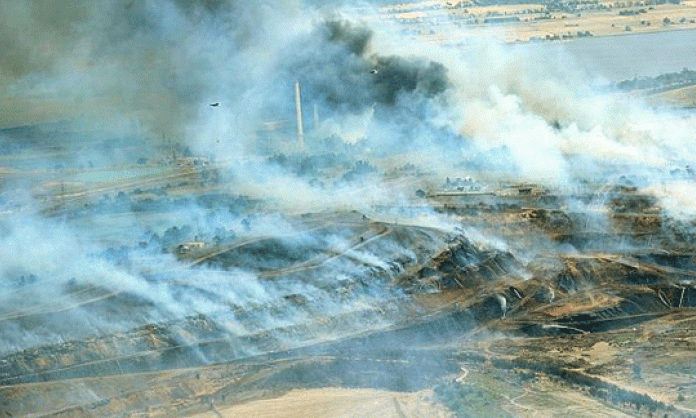People poisoned on an industrial scale. On the evidence available, there are dozens of people dead. So far, the authorities haven’t bothered to count.
Welcome to the Latrobe Valley, just an hour or two’s drive from Melbourne. These are the working class communities that for decades have dug the coal, fired the power stations and supplied electricity to the whole of Victoria. The entire wealth of the state depends on these towns and the workers who live in them.
Last year, they were poisoned wholesale.
A new book by Tom Doig, The Coal Face, tells the shocking story of the fire that burned out of control in the Morwell open cut coal mine for 45 days early in 2014. Morwell and other towns in the Latrobe Valley were blanketed with toxic smoke and gases.
Doig tells the story as it deserves to be told: in a gripping, easy-to-read book with plenty of quotes from those on the front line of one of Victoria’s biggest industrial disasters.
He tells of the dramatic events that unfolded when years of corporate neglect exploded. A small fire – the exact source is still not clear – turned the disused northern wall of the coal mine, 130 metres high and several kilometres long, into a wall of flame. CFA firefighter Doug Steley describes it: “Imagine as far as you can see, the ground itself is burning. The trees are still there, but the earth underneath the trees is burning … It fills the horizon. It’s all you can see … Holy bloody hell, the whole hill is on fire.”
Doig details how a network of rotating water sprays was laid over the worked-out faces of the mine when it was first worked in the 1960s. On hot days this network would be switched on: no fire could start or spread.
As Victoria’s State Electricity Commission was run down, this network of pipes and sprinklers was allowed to deteriorate. In 1994, in the run-up to privatisation, the requirement to maintain it was scrapped altogether. The new owners, International Power, ripped out the pipes. According to the workers, they were sold for scrap.
Thanks to this profit-boosting negligence, as multiple fires took hold across the open cut on 9 February, there were no sprinkler systems and few hydrants to put out the fires (expensive, and highly profitable, production equipment was well protected).
At an early, crucial, stage of the fire, the fight was critically hampered by the lack of backup power – one of the ABCs of fire prevention at industrial facilities. When the fire cut the power lines, the water pumps failed. Doug Steley drove one of the few tankers that could find water, but returning with a single tanker seemed almost pointless. “What’s 3500 litres gonna do against a burning hill of coal?”
Not much.
By the morning of 10 February, a fire more than three kilometres long and more than 100 metres high gripped the northern and eastern walls of the mine. On the floor of the mine, an area about 12 times larger than the MCG’s playing surface was well alight.
It would be more than a month before these colossal coal fires were declared “under control”. In the meantime, a plume of ash, gas and toxic chemicals spewed into the surrounding communities.
‘The smallest animals died first’
Doig records the backyard chickens that dropped dead, as ash smothered the town of Morwell. He records the household dog that started bleeding from its paws and then from every cavity of its body.
He records the children whose asthma (already an epidemic in the Latrobe Valley) became so bad they would cough until they vomited. Throughout the valley, people were noticing that they, and everyone around them, were sick in a way they had never been before. Headaches, nausea and night sweats. A sore throat that’s like swallowing razors. Some people retching, many fighting for every breath.
And all of a sudden, there seemed to be a lot of people dying.
How many people? It’s a question the authorities have been reluctant to ask, let alone answer. The activist group Voices of the Valley wrote to Births Deaths and Marriages, asking for numbers. Births Deaths and Marriages took their time replying, so the activists did their own research.
“I just went, ‘what the fuck? This can’t be right …’”
Activists looked through the obituary columns from the local newspaper, the Latrobe Valley Express, and found that, in an average March, 64 residents of the Latrobe Valley will die. Last March, however, as the toxic plume spread, this rose to 91 people – a jump of nearly 50 percent.
Death statistics can be hard to interpret. A long heatwave, for instance, will lead to a sharp rise in mortality. Taking this into account, a detailed analysis by health statistician Adrian Barnett shows at least 11 excess deaths during February and March last year. Official figures on the months February to June show a five-year average of 294 deaths across the Latrobe Valley in that period. In 2009, the year of a massive heatwave and the catastrophic fires (which burned 11 people to death in the Latrobe Valley), that figure spiked to 323 deaths. Last year, the figure was even higher: 339 deaths. The spike in deaths continued right through June, long after the fire was declared “safe”. No one has looked at the figures since.
The valley responds
Doig’s book recounts the role played by Socialist Alternative member Naomi Farmer, who grew up in the Latrobe Valley. An article by Naomi, written two weeks into the fire, went viral and helped finally to break the story.
Then she was instrumental in calling a rally. As Doig records, Wendy Farmer (Naomi’s mum) had never taken an interest in politics before: “Wendy had hoped the rally would be big, 200 or maybe 300 people. On the day, more than 1500 people turned up. Miners and greenies and housewives and bikers all crowded together.
“Naomi had brought a megaphone and she encouraged people to say their piece. Afterwards she gave Wendy the megaphone to hold for a second. Wendy didn’t give it back. She ended up at the front of the march, yelling, ‘Disaster in the valley! We need help!’ with everyone joining in behind her.
“Wendy had discovered a hidden talent: rabble rousing.”
The informal organising committee for the rally became Voices of the Valley. They organised protests, health surveys, media coverage and, eventually, an electoral campaign than came within a handful of votes of unseating the long time National Party member for Morwell, Russell Northe. As Labor jostled for the seat, state ALP leader Daniel Andrews pledged, several times, to reopen the inquiry into the mine fire to look at the impacts on health and on death rates.
Just a few days after Tom Doig launched The Coal Face, and sent a copy to Daniel Andrews, the new state government announced the inquiry will be reopened in May. Perhaps now, those murdered by the Morwell mine fire will finally be counted.
The mine still smoulders. Fires in coal mines, it seems, never really go out. The health fallout also continues: ceiling cavities throughout the Valley are still infested with the superfine, toxin-laden ash belched out by the fire. As time goes on, no doubt the deadly effects of the fire will shade into the general ill health that is the lot of Latrobe Valley residents.
These communities house generations of workers whose labour has powered the entire state of Victoria, whose labour is essential for every cent of the wealth that flows through the corporate towers on Collins Street.
Their reward for this is a wage packet (if they’re lucky) and an early death. As Doig notes (and as the Morwell mine fire inquiry documents), Latrobe Valley residents die four years earlier than the Victorian average and battle ill health and disability for many more of those years. This latest toxic blast will no doubt worsen these already grim statistics.
The profits generated by Hazelwood power station, fed from the Morwell mine, continued to flow through the crisis. A lot of digging and some rough calculations show that GDF Suez (Hazelwood’s current owner) generates $1400 per minute in gross revenue from the operation. Apart from a brief interruption in the first 24 hours of the fire, this revenue stream continued to flow. The equipment, and the cash flow it generates, is the priority in any firefight, and is protected by an extensive and well-maintained sprinkler system.
Residents of the Latrobe Valley, whose lives and deaths don’t figure in the power industry’s profit calculations, did not fare so well.
----------
Tom Doig’s The Coal Face is out now, published by Penguin.









